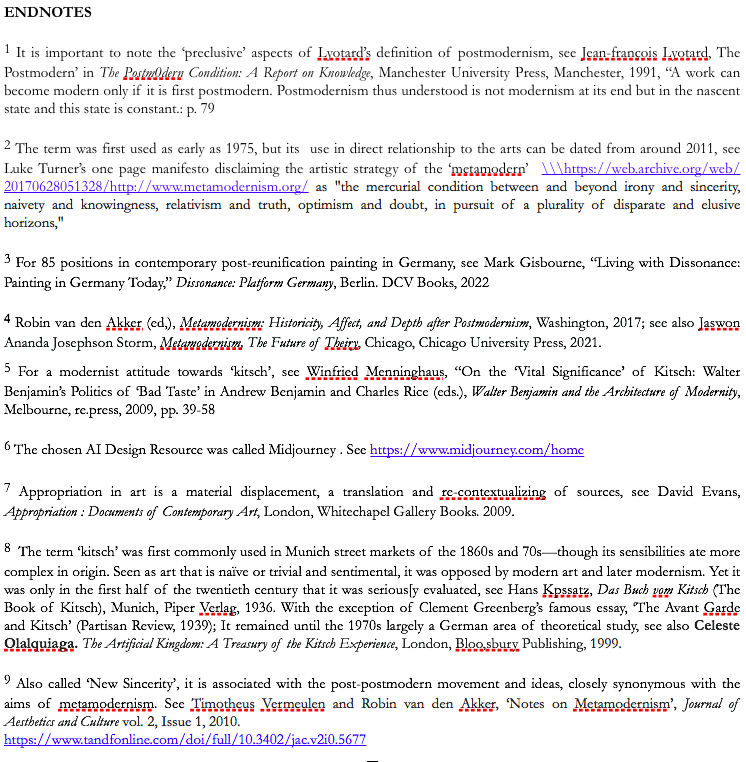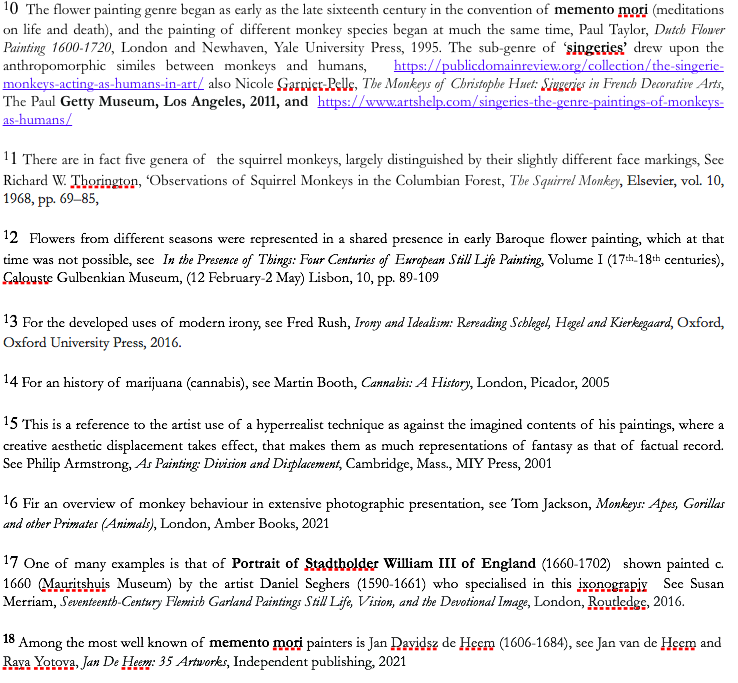Heile Welt
Karl Oskar Gallery
March 6 - April 17, 2024
Peter Wilde, Heile Welt, 2024, acrylic on canvas, 60 x 80 cm
The symbolism of monkeys and roses in art traces back through centuries of cultural and artistic evolution, embodying a myriad of meanings across different contexts and civilizations. Monkeys, often depicted in various mythologies and religious traditions, have symbolized a wide range of traits including mischief, wisdom, playfulness, and even divine intervention. In art, they frequently serve as allegorical figures, representing the complexities and paradoxes of human nature. Roses, on the other hand, have been revered for their beauty, fragrance, and symbolism of love, passion, and renewal since ancient times. The juxtaposition of monkeys and roses in art creates a captivating tension between the wild and the cultivated, the primal and the refined, inviting viewers to contemplate themes of duality, desire, and the interconnectedness of all living beings. This enduring motif continues to inspire artists to explore the intricacies of the human condition and the eternal dance between chaos and order.
“Monkey Business” (Images of Ironic Sincerity)
Mark Guisbourne
The new paintings by Peter Wilde come as a shock when seen in the wider context of his earlier thematic approaches to subject matter. The paintings challenge and at the same time revivify many contentious and questionable saws of modernist aesthetics. Yet following from the diminished former conventional teleological trends of narrative modernism, and the heterogeneous and fragmentary preclusive assertions of the postmodern, we are left somewhat bereft as regards feelings of aesthetic certainty.1 The polarity of teleological modernism and the heterogeneous plurality of postmodern painting, has led us into a relative state of confusion visually presented and played out in the image making of today. This said recent thought has gravitated towards a new form of self-defined synthesis called the ‘metamodern’, which while acknowledging the inadequacies of determinist modernism at the terminus of grand narrative thinking, similarly questions the ‘anything goes’ relativism and diverse forms of ironic cynicism expressed by postmodernism.2 But various uses of irony is central to painting over recent decades and often conveyed as a sense of pictured dissonance, that far from being constructive has had at times deleterious effects.3 Given the self-reflexive knowledge of so much contemporary painting, the idea that is presented by metamodernism seeks to turn the use of irony towards a positive and sincere creative use. The concept hopes by taking the residual and progressive aspects of modernism, fused with the self-reflexive aspects of postmodern material praxis, to recreate a synthesis and radical aesthetic approach to painting, When set in this context the new paintings of Peter Wilde can be seen as both provocative and solicitous.4
It is evident at first sight that Wilde’s Squirrel Monkey and floral motif paintings have little to so with investigative zoology or botanical resources. But rather operate as generative pictorial tropes that deal explicitly with affective sentiment and actively challenge the negative history associated with the aesthetics of kitsch.5 In fact the artist makes it quite clear that the subject matter is informally chosen in relation to his use of an AI system that generated the source images, and which in turn served as an initial point of departure for the paintings.6 This stands in marked distinction to the artist’s earlier series of themed works (focusing on questions of human and constituent identities), created in relation to sources of conceptual appropriation and aesthetic displacement.7 In the present instance we might speak alternatively of a translation from contemporary virtual self- generative technologies to pictorial states of re-materialisation, subsequently expressed in meticulous terms as hyperrealist paintings. The reference to ‘kitsch’ is to intentionally acknowledge that kitsch as a term derives from the mid-nineteenth century, at the same incipient preclusive moment of modern art.8 For kitsch shares in the same affective background sources (namely modern life), except that it is generally distinguished through a series of sensory dichotomies, defined as the nostalgic and the melancholic, the remembered and the recollected, with a yearning for the immediacies of sensory visual pleasure. Hence far from being a negative impulse its sentimental evocation connotes the good will intended by recent ideas of metamodernism, that is to say a progressive pursuit of creative sincerity in the knowledge and acceptance of increased ironic self-understanding. Since irony is linguistically dialectical in nature, the saying of one thing that carries the inference of its opposite, Wilde’s paintings express synthetic states of ironical sincerity.9
The subject matter nonetheless is also a given synthesis, that is to say a contemporary fusion of distinct genre representations, evoking historical flower painting and the animalier sub-genre that became autonomous categories of European painting in the seventeenth century.10 The Squirrel Monkey is indigenous to the countries of the Amazonas basin in South America, where it lives in the upper canopy of the rainforests. But it is evident in Wilde’s paintings that the floral arrangements, and chosen settings in which the monkeys are presented, have no botanical relationship to the primate’s natural habitat.11 Thus the images are intended to be seen as pure artifice as paintings, though one of a perversely intended presence, since the flowers depicted (largely roses and different blossoming shrub sources) generally share the same botanic or seasonal temporality, which distinguishes them the traditionally intended ‘artificiality’ of the genre of oil-based flower painting.12 In Peter Wilde’s paintings we also experience a hyperrealist reworking of the theatricality of the baroque in the scrupulous use of masterly detail and realistic description on the one hand, and conversely its opposite anti-baroque in the inferred uses of irony and the self-knowing strategy inferred at closer viewer regard.13 A central characteristic of irony is a common synonym of humour and wit, and in a painting called A New Leaf a single cannabis leaf has been added, simply ’painted in’ acknowledging its recent de-criminalisation in Germany.14 Hence there is a certain pictorial elasticity of what is visually experienced between process and scene, the detailed technicalities of the paintings execution, set against the fantastical visual contradictions of the scene settings that are incorporated as subject matter15 In this respect they give further credence to his representations of monkeys as ‘images of mischief’, an iconography and codicil to the ‘monkey business’ as the title to this essay.
In a closer look at the paintings a certain unity exists in the fact that in most instances the monkeys make eye contact with the viewer. In this respect they make an obvious reference to the conventions of portraiture, and thereby further the post-Darwinian tradition of the idea of primate anthropomorphism. If in earlier historical periods the monkey was a behavioural simile of the human, in the post-evolutionary world they became deemed to be genealogical ancestors.16 At the same time embedded within their accompanying effulgent florescence they share with portraiture a sense of memorialisation, and Baroque portraits were often garlanded with floral and fruit arrangements in a similar manner.17 In both cases (human and ape) they were also seen as indicative of reproductive fertility and fecundity—licentious or otherwise—a common characteristic that have been long attributed to the simian nature. However, in Wilde’s paintings the monkeys are shown unfettered, as might not have been the case in earlier depictions, and this gives them a sense of singular autonomy and dignity. In some cases we are presented with feelings of chance encounter and the arrested moment, as in the Heile Welt title work of the exhibition. Whereas in other instances the position of the animal appears set and composed as in Pile or In the Blue Room or Coming Up 1, and many other examples in the painted series. The monkeys are always presented either immersed within exquisitely composed floral bouquets, or in close proximity as flora to fauna, as the animate and inanimate, the living and the dead. Since the flowers represented are invariably cut flowers, moreover the blooms are ‘full blown’ and destined to all but immediate death. They are images of flowers in an arrested or transitory state during the short life of a remaining existence18.
It would be wrong to assume that because this group of works has been executed in a hyperrealist style of painting, and that they are simply a repeated schematic. Over the last twenty years or so the artist Peter Wilde has worked across several styles of figurative painting, from the expressionistic fracture to digital similitude, museum figure studies, the male nude, a use of modernist grid installations and much else. The fact they are produced as defined series, reveals that the artist works through preparatory ideas and indicates there is a conceptual bias that underpins his overall approach to art making. The practice of singularity within plurality carries connotations of the aforementioned ideas of metamodernism (post- postmodernism), where the serialisation of modernism reintegrates the heterogeneous and cynical aspects of the postmodern. It allows the viewer to rethink the deterministic view of art over the last hundred or so years, question its exclusions and scrutinise modern and postmodern assumptions. In painting this can only happen within the ironic sense of self-knowledge as to what has gone before. It is painting as an act of pictorial redemption of sorts, be achieved under the aegis of good will and a and a sincere sense of irony.























